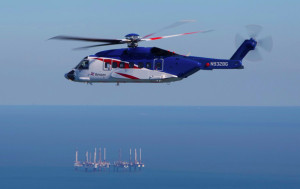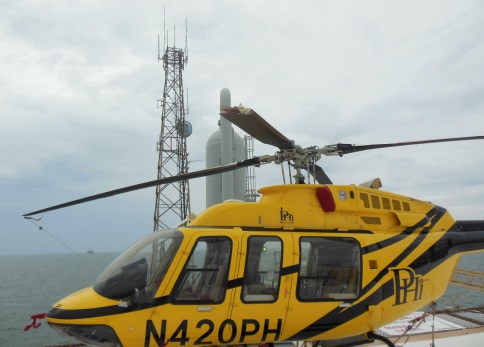Helicopter Ops and Safety – Gulf of Mexico 2015 Update
The Helicopter Safety Advisory Conference (HSAC) has been publishing data on the Gulf of Mexico (‘GOM’) offshore helicopter fleet and its safety since 1995. We looked at their 2014 data previously and now examine their 2015 data.
Helicopter Operations: GOM Fleet Data
HSAC report that flying activity is in decline, with just under 228k flying hours in 2015 (vs 298k in 2014 and 410k in the peak year of 2007), using 346 helicopters (vs 415 in 2014). Flying hours, passenger numbers and flights have dropped by 28%, 20% and 34% respectively over the last 5 years.
These helicopters were operated by 10 companies (vs 13 in 2014). The big three are Bristow, ERA and PHI, with RLC strong in the single engine sector.
The number of smaller helicopters continues to decline with single engine helicopters down 38% over 5 years, light twins 33% and medium twins 26%. The number of heavy twins (mainly Sikorsky S-92As) however has doubled in the last 5 years to 50 (up 4 since 2014).
This is indicative of the economic decline in the small ageing coastal fields and more deepwater exploration and production (as demonstrated by the last few seconds of the animated map below, a 2008 MMS report and a deepwater field status listing).
In 2015 the average utilisation was:
- Single engine – 711 flying hours with an average 19 minute sector length (vs 590 flying hours and 20 mins in 2014)
- Light twin – 460 flying hours with an average 19 minute sector length (vs 441 flying hours and 17 mins in 2014)
- Medium twin – 606 flying hours with an average 33 minute sector length (vs 794 flying hours and 38 mins in 2014)
- Heavy twin – 715 flying hours with an average 35 minute sector length (vs 805 flying hours and 36 mins in 2014)
The medium / heavy twin usage per aircraft is approximately 20% less that the average for the UK North Sea fleet, partly due to the greater use of pooled aircraft to meet sole use contracts in Europe. The decline in medium and heavy usage suggests that similar arrangements at some of the larger bases could result in cost savings.
Helicopter Safety GOM
HSAC say there were three accidents in 2015, all non fatal (vs 4 in 2014, one fatal). The US National Transportation Safety Board (NTSB) however reports four, all involving single engine helicopters:
NTSB Identification: CEN15LA156
On February 20, 2015, about 0750 central standard time, an AgustaWestland AW119 MK II [Koala] helicopter, N802SM, experienced an abrupt, uncommanded left yaw during cruise flight over the Gulf of Mexico. The pilot and three passengers were not injured. The helicopter sustained substantial damage. The helicopter was registered to and operated by Era Helicopters LLC., under the provisions of 14 Code of Federal Regulations Part 135 as an on-demand air taxi flight. Visual meteorological conditions prevailed for the flight which operated on a company visual flight rules flight plan. The flight departed the Houma-Terrebonne Airport (HUM), Houma, Louisiana.
After the uncommanded left yaw, the pilot returned to HUM and performed a run-on landing. A post-flight inspection of the helicopter revealed one of the tail rotor pitch change links was fractured. No additional damage to the helicopter was discovered. The pitch change link was retained for further examination.
UPDATE 29 November 2016: Probable Cause: The fracture of the tail rotor pitch change link due to excessive bearing rotational friction, which resulted from the bearings being installed in exceedance of the maximum allowable torque during the last overhaul of the pitch change link.
NTSB Identification: CEN15LA265
On June 8, 2015, at 1432 central daylight time, a Bell 407 helicopter, N501PH, made an autorotation to the ground near Pecan Island, Louisiana. The pilot and four passengers were not injured. The helicopter sustained substantial damage. The helicopter was registered to and operated by PHI Inc., Lafayette, Louisiana, under the provisions of 14 Code of Federal Regulations Part 135 as an air taxi flight. Visual meteorological conditions prevailed at the time of the accident and a company flight plan was filed. The flight originated from Vermilion Block 256-E in the Gulf of Mexico and was en route to Pecan Island.
UPDATE 23 March 2017: Probable Cause: The fatigue fracture of the tail rotor gearbox attachment studs, which resulted in a loss of tail rotor control and a subsequent hard landing.
NTSB Identification: CEN15LA288
On June 28, 2015, about 1000 central daylight time, a Bell 407 helicopter, N311RL, was substantially damaged when strong winds blew it over the side of the helideck during engine start on the South Timbalier 127 oil platform in the Gulf of Mexico. The pilot received serious injuries. The helicopter sustained substantial damage to the fuselage. The aircraft was registered to GM Leasing Company LLC, and operated by Rotorcraft Leasing Company LLC, under the provisions of 14 Code of Federal Regulations Part 135 as a passenger flight. Visual meteorological conditions prevailed for the flight, which was not on a flight plan. The flight was originating at the time of the accident for an unconfirmed destination.
UPDATE 3 October 2016: Probable Cause: The pilot’s lack of awareness of the severity of the gusting winds, which led to the helicopter being pushed off of the oil platform by a wind gust during engine start. Contributing to the accident was the unavailability of a nearby weather monitoring system.
NTSB Identification: GAA16CA039
On October 30, 2015, N420PH, a Bell 407 of PHI, lost most of one rotor blade in an accident on an offshore installation in the Gulf of Mexico at WC167 (see our earlier article: Troublesome Tiedowns).
The operator reported that the pilot landed and shutdown the helicopter on an offshore platform. He secured the main rotor system by attaching a tiedown to the forward left main rotor blade and he then attached this tiedown to the left front skid cross tube. Several hours later, the pilot entered the right front seat to begin the engine start sequence. The operator reported that the pilot proceeded to start the engine and noted a few seconds after initiating the engine start that the helicopter made an “unusual noise” and began to shake. The pilot then shut down the helicopter without further incident. A postflight inspection revealed substantial damage to the blue main rotor blade.
The operator reported there were no pre-impact mechanical failures or malfunctions with the airframe or engine that would have precluded normal operation.
Probable Cause: The pilot’s failure to remove a main rotor blade tiedown, which resulted in substantial damage to a main rotor blade when the engine was started.
Consequently, according to HSAC:
- The 2015 accident rate was 1.31 per 100k flying hours (vs 1.35 in 2014), compared to a 32-year annual average accident rate of 1.72. Note: The 2015 rate would be 1.73 per 100k flying hours if all 4 occurrences listed by the NTSB are included.
- The 2015 fatal accident rate was 0 (vs 0.34 per 100k flying hours in 2014), compared to a 32-year annual average accident rate of 0.42.
It is noticeable that the smaller single engined helicopters, which make up 51% of the fleet, 55% of the utilisation and 72% of the sectors, drive the accident rate. Only one of these four accidents in 2015 appears to involve powerplant though with one involving a tail rotor failure and two operational helideck issues.
UPDATE 3 June 2017: Our 2016 review.
UPDATE 14 September 2016: Helideck Safety Alerts: Refuelling Hoses and Obstructions
UPDATE 23 June 2018: Our 2017 review.
UPDATE 28 February 2019: Our 2018 review.
UPDATE 20 December 2020: HSAC finally release their 2019 data: Helicopter Ops and Safety – Gulf Of Mexico 2019 Update



Recent Comments